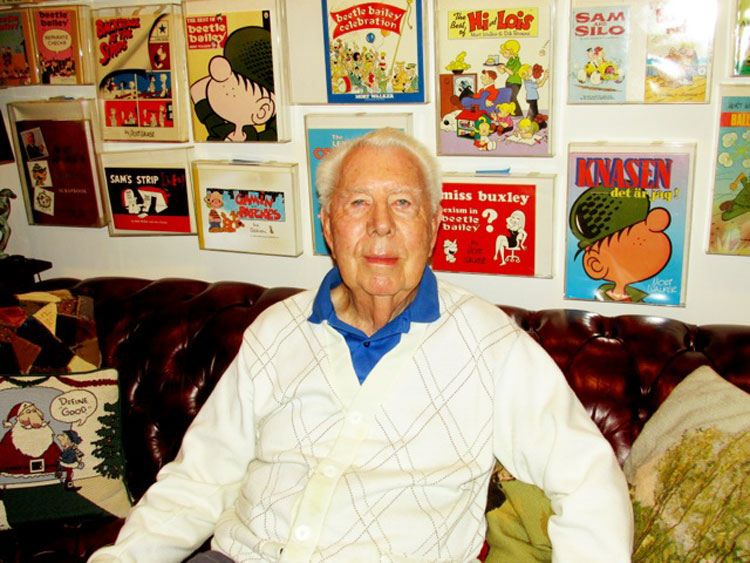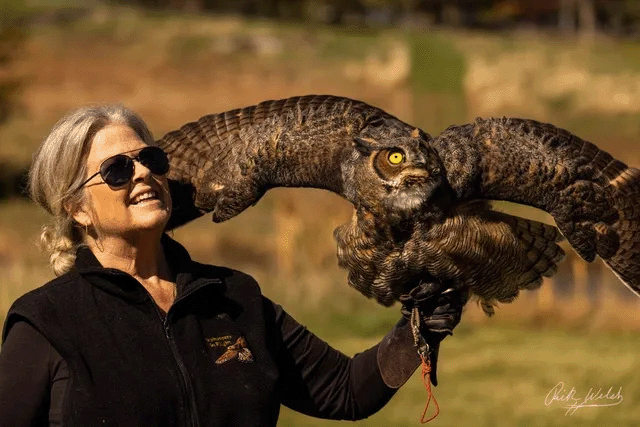
By Anne Semmes
Sentinel Staff Reporter

Mort Walker, that enduring cartoonist, late of Greenwich but alive and working at 92 in Stamford, is being celebrated for the lasting appeal of his Beetle Bailey comic strip as the longest running comic strip in history to be drawn by the creating artist—65 years and counting.
Mort was thus featured on a recent CBS-TV Sunday Morning show marking the 100th anniversary of William Randolph Hearst’s King Features Syndicate, which has carried Beetle Bailey since its debut on Sept. 4, 1950.
So what’s the secret of the lasting appeal of that inventively slothful U.S. Army Private Beetle Bailey and his crowd at Camp Swampy? “I keep coming up with things that make ’em laugh,” says Mort.
“It’s good to laugh,” is Mort’s maxim. He refers to cartooning as “the happy art.”
Then there’s his 61-year-old Hi and Lois strip with its suburban antics and “thinking” baby Trixie. “Hi and Lois is patterned on my own family,” says Mort. Talk about a wealth of material! Between them Mort and second wife, Cathy, have ten children.
Cartoonist Jerry Dumas, Mort’s longtime collaborator, says, “Mort has a natural gift for drawing and for writing funny cartoon gags, but there’s one other thing—his very strong work ethic. He has the ability to apply his pants to the seat of his chair until the job is through.”

Dumas, once a regular contributor to The New Yorker and the Saturday Evening Post in addition to his comic strip work, began his tenure with Mort on Beetle Bailey in 1956. Five years later the two created the cult classic Sam’s Strip, about a comic strip character who runs his own comic strip. (Sam’s Strip later evolved into Dumas’ still-extant Sam & Silo, set in the small town of Upper Duckwater.)
Dumas also cites Mort’s relentless quest for gags—for new and unexpected comic scenarios. “Mort desires lots of gags then skims the cream off the top,” says Dumas. “He’ll want 100 gags to choose 20 from. We’ve built up a plethora of gags.”
Imagine 60,000 gags or more stashed in Mort’s Stamford garage, gathered by Mort and his team that includes Dumas and Mort’s three collaborating sons (of his seven children), Brian, Greg and Neal. All—except Dumas, on this day—have arrived for their monthly two-hour gag meeting. They gather in Mort’s office, situated in his stone manse, the former studio of Mount Rushmore sculptor Gutzon Borglum.
Mort long ago embraced his sons in his cartooning enterprise, and they come willingly. Greg works with Mort on Beetle Bailey, inking in Mort’s pencil drawings. Mort has handed off Hi and Lois to sons Greg and Brian, and another second-generation cartoonist-illustrator, Chance Browne, whose father, Dik Browne, was the original Hi and Lois artist (and also the creator of the much-loved Hagar the Horrible).
Brian and Greg have been working on Hi and Lois upwards of 40 years, says Brian. “Looking back across the years of Hi and Lois is like reading a diary of our family life.”
Mort sits in his office surrounded by trophies and framed book covers and cartoons. He displays a few gag sketches he’ll share at the meeting. “We each put 30 gags on the table,” he says. “We pass them around and each put a vote of one, two, or three on the back of each one.” Ones they like, twos need fixing, and threes are no-likes. “If they’re dirty they get a six,” Mort jokes. “They love the dirty stuff in Europe. Scandinavia says ‘Send us your sexy gags.’”
Mort will make a selection of the best new gags and lay them out on his pool table. “We’ll choose from the ‘ones’ for a week of strips,” he says, and that leaves 90 leftovers every month, hence the growing mountain of gags in the garage.

So, where does the humor come from? “From observing life and seeing people’s frustrations,” says Neal. Mort sometimes conjures up gags in the middle of the night. “When I take a nap, I get two gags before I go to sleep,” he says. “If I go to the doctor, I take my notebook with me and think of gags when I’m waiting. It’s like writing a diary for me.”
In fact, stretches of Mort’s long, good life surface often in Beetle Bailey. “In World War II, in the army, I used my expertise to evade work and do what I wanted to do,” he confesses. “I was going out with this beautiful girl. I stuffed my bed like I was sleeping in it and slid down the pipes. I did that for a year and never got caught.”
The lucky Mort produces his small black pocket notebook from which he reads out a list of challenging new buzzwords: cloud, uber, airbnb, app, gig economy, emojis. “Now,” he says, smiling, “I’m with it.” Like the rest of his team, he works to stay au courant.
“We’re always trying new stuff,” says Neal. “The strip now has drones and cell phones as well as old fashioned phones and a techie geek.” Beetle’s crowd has “the same frustrations with computers crashing” as the rest of us do.
Mort has tiptoed into the present political fray: “I brought in Donald Trump. But I try to stay out of Syria.” He’s wary of the prevalent drift of comic strips into political cartoons.
“People read political references into everything,” notes Neal. “We can’t even mention the president’s name,” he says, without risking the sort of reaction that would distract from the humor.
Their monthly meeting done, the team will move off to lunch at either the Silvermine Golf Club or the Rye Ridge Deli. And therein lies part of the attraction of the collegial atmosphere that keeps the Walker cartoon enterprise going.

“You have the freedom to have your own hours,” says Greg. “Both Dad and I play golf. Yesterday, he played 18 holes—I played nine, then I worked till night.”
Brian is considered one of the country’s leading comics historians and comics exhibit curators; long ago he helped establish Mort’s Museum of Cartoon Art, which was located first in Greenwich, then in Rye Brook, and finally in Boca Raton, Fla. The cartoon museum is now permanently housed at Ohio State University, in Columbus, Ohio, as part of the Billy Ireland Cartoon Library & Museum.
Brian says he greatly values the perks of working with Mort. “I am close to home and I’ve been able to be around my kids, to go to their games and know their friends and girlfriends.”
“Cartoonists are pretty nice people,” Brian adds. “They have a degree of fame, but are not too famous.”
Dumas can recall those golden years of the 1960’s and 1970’s, when Fairfield County was casually known among cartoonists as “King Features East.” “There were so many of us cartoonists living close together,” he says. The cartoonists and their wives would often gather on Friday and Saturday nights and, amid copious drinking and smoking, crack jokes with the goal of getting big laughs. “The cartoonists’ parties were more off-the-wall than regular neighborhood parties,” Dumas says. “It was a pleasure to stand beside another cartoonist and trade cracks.”
“It was a great fraternity,” says Mort. “We were always ready to help each other—if we went to New York on the train for meetings, we’d sit in the bar car and laugh and joke. We play golf every week,” even when the weather barely permits it. “It gets us outdoors. This place is a jail, in a way. But it’s great working with my boys.”

Mort’s fame is found daily in his mail. He gets half a dozen fan mails a day, in letters, packages, or requests for old comic books. The most common phrases he comes across are “I’ve been reading you all my life” and “Can you send me a drawing?”
Beetle Bailey, which started in just 12 newspapers, appears today in 1,800 newspapers in 52 countries. Mort just received an award for Beetle Bailey from the First Biennial of Caricature Brazil, where master of ceremonies Luciano Magno declared Mort “the master of cartoonists.” In Brazil the strip is called “Recruta Zero.” “It’s the number one comic magazine there,” says Mort. “Beetle Bailey has different names in different countries. In Finland it’s known as ‘Flippy Flink.’”
Beetle enjoys special popularity in Scandinavia. Not long ago, at a comics convention in Norway, Mort says, “There were so many in line they moved me upstairs. I never saw the end of the line.”
Postscript: Mort Walker was featured this year in the exhibition “King of the Comics: William Randolph Hearst and 100 Years of King Features,” as curated by Brian Walker. Mort’s comic art will travel to Madrid for a 2017-2018 exhibit in The Museo Nacional Centro de Arte Reina Sofía.




